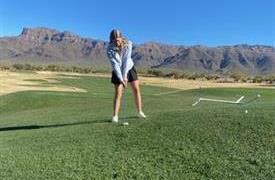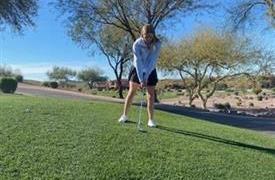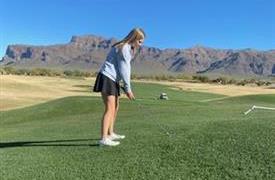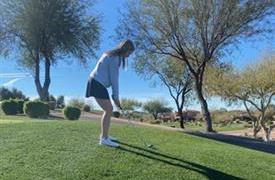How to Handle Uneven Lies
As a golf instructor at Superstition Mountain, PGA Pro Dan Williams has experience in helping members conquer some of the more challenging aspects of the game. He shared some insights into one of the most common frustrations he sees, not being able to effectively take your game to the course.Your golf swing is good on the range, but when you get to the course … not so much. A common reason for this is the practice tee is typically very flat and the golf course rarely is, so if you can understand how to handle standing on slopes on the golf course, you can maintain your normal swing and see more solid contact and better results! Below are some tips for managing uneven lies on the course.
Uphill Lie

If your ball is on an uphill slope, it is essentially adding loft to the club. This will cause the ball to fly higher than normal, so you’ll want to club up one, so the ball doesn’t come up short. You also want to match your shoulders to be as close to parallel to the slope as possible, this will allow you to make your normal swing and give you the best chance at solid contact.
Downhill Lie
If your ball is on a downslope, this will deloft your club, causing the ball to fly lower than normal. This means the ball will land on a flatter trajectory and roll more than normal. You will again want to match your shoulders to be as parallel to the slope as possible to allow you to make your normal swing and have the best chance at good contact.
Ball Above Your Feet 
When the ball is above your feet, you’ll want to grip lower on the club because the ball is closer to you than normal. Gripping lower will shorten the club to allow you to take a normal swing. Shortening the club can make the ball fly a little shorter, so you may want to take an extra club to avoid overswinging. The ball will also tend to have draw spin in this situation, so you should aim slightly to the right of your target to account for the curve (for a right handed golfer).
Ball Below Your Feet 
When the ball is below your feet, you should bend your knees a little more than normal to get you closer to the ball, allowing you to make your natural swing. Bending your knees can limit rotation in the golf swing which can lead to a shorter ball flight, so you may take an extra club to avoid having to swing extra hard. The ball will also tend to have a fade, so you should aim slightly left of your intended target (for a right handed golfer).
These situations can create a big challenge for golfers, so if you apply these adjustments, you can start to take advantage of them without making significant changes to the motion of your swing.
You should still practice a little though!
Interested in learning more? Check out these tips from Dan:
Fix your golf slice, for real this time
How ball position and stance can help your golf game
Members can book a lesson with Dan, by emailing: dwilliams@superstitionmtngc.com


